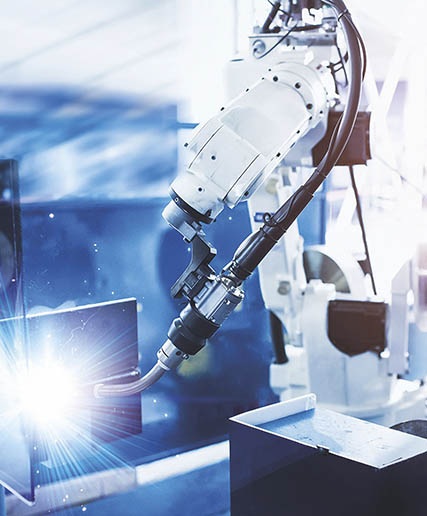VIRO Business Program
Achieve your goals in realistic steps


Achieve your goals in realistic steps
You want to drive your organisation forward. Which challenges will you come up against along the way? How can Smart Model-Based Systems Engineering help you progress? The VIRO Business Program is designed to help you to get off to a great start.
1 Value chain analysis
We always start with a baseline measurement: an analysis of the data flows in your primary process. We then compare the results with our Industry 4.0 vision model to identify potential areas for improvement.
2 Define your goal
In the second step, we identify your strategic goal(s): for example, reducing the lead time. To achieve this, we draw up various scenarios, from which you choose one.
3 Draw up a roadmap
We draw up a realistic roadmap to achieve your goal(s). The roadmap puts you on the right track towards a SMART product design and is supported by all stakeholders.
More value for your machine at a lower cost
Developments in the context of Industry 4.0 usually require a reassessment of value engineering. We take care of that for you. We analyse your current machine design; can we cut production costs, integrate functions, and/or reduce the carbon footprint?
We analyse the functions that have the most customer value and explore how they
1) can add even more value;
2) can be produced more cost-effectively.
The VIRO SMBSE engineering team then sets to work designing your new modular product concept. We also involve your future supply partners in this process. After a series of joint interim evaluations, we then develop the entire model for you.
Modular products and a 'best fit' organisation
The core modular model is defined in the value engineering phase. Within this model, our engineers now proceed to design the individual modules, which together form a homogeneous and interchangeable family.
1 Modular Function Deployment
We work closely with your marketing and sales staff to identify your customers' requirements and expectations. We integrate these into the designs for each module in a smart, efficient, and innovative way.
2 Business Process Redesign
The transition to using a modular product family affects all departments and processes within your organisation. We provide specialist workshops on this topic.
3 Software Selection & Implementation
The transition also has an impact on the software. You will start using a modular system architecture and a product structure that leads (via a configurator) to the physical modules.
VIRO's software and automation specialists take care of the selection and implementation of the relevant software.
Identify opportunities and risks in good time
Based on our experience, we recommend that you start by commissioning your platform and modular products virtually. This shortens the time to market, avoids potential failure costs, and secures support from stakeholders.
During the virtual commissioning phase, we use digital 3D simulations to verify and validate the capabilities and identify potential improvements. This can be done at various levels, from a single work cell or assembly task to the entire production line.
During this phase, we also simulate the interaction between mechanical, electronic, and control systems so that we can identify opportunities and shortcomings at an early stage.
Click here for more information about virtual commissioning by VIRO.
Insights that take you further
Data-driven manufacturing is all about using hard facts (data) and robust KPIs to drive your production processes and decision making. This offers you a greater degree of certainty, predictability, and peace of mind than traditional assumptions or anecdotal evidence.
Benefits of data-driven manufacturing:
The increasing pace of digitisation makes it possible to collect real-time data on your activities. The real benefit lies in the insights that you can draw from this: for example, into the throughput, the quality, and the bottlenecks in your production processes.
VIRO's SMBSE team can help you to set up a data-driven production process in line with the requirements of your modular platform.
Tool for smarter production, maintenance and design
A digital twin of a machine or module can be useful for a variety of reasons. For example, it can be used for virtual testing or to monitor and analyse the production process remotely. This data can then be used to optimise planning, cut lead times, and predict the best times to carry out maintenance.
The Digital Twinning specialists on VIRO’s SMBSE team work closely with you to determine
• why a digital twin could help you
• the machines/modules/components for which a digital twin would be beneficial
• which information is required for this
• how to ensure that your digital twin functions correctly
See also: How can automation improve the quality of your machines?
New business cases with your machines
Servitisation is not about your machine, but about your customer's needs. We are all familiar with the concept; just think of the coffee machine in your office. You lease the machine, and the manufacturer takes care of the maintenance, repairs, and the coffee.
Since digitalisation and modern technology are making machines much smarter, opportunities are opening up to not just sell the customer a product, but to completely relieve them of any worries. This goes much further than traditional, reactive maintenance.
Process optimisation
Thanks to sensor technology and the Internet of Things (IoT), you can collect real-time data on the operation of the machine. By analysing this data, you can, for example, offer predictive maintenance or advice on how to optimise processes.
Product-as-a-Service
By offering Product-as-a-Service (PaaS), you focus on the output of the machine, including maintenance and service. You negotiate prices with your customers per unit of output produced.